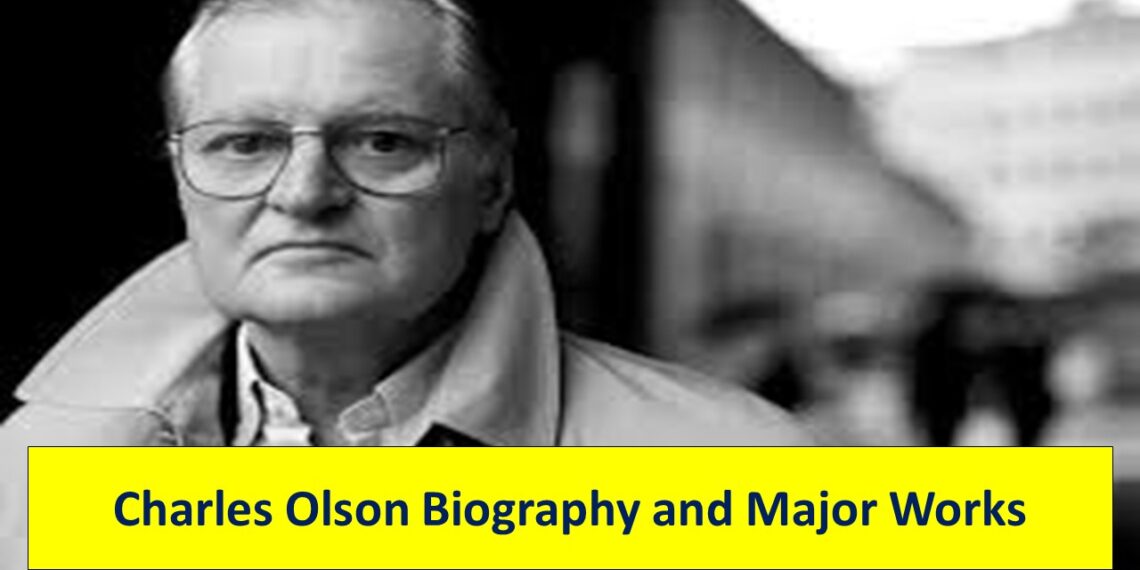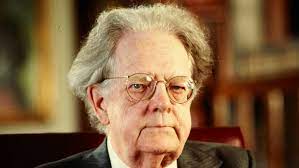Early Life:
Charles Olson was born in Worcester, Massachusetts, on December 27, 1910. Raised in a working-class family, he attended Wesleyan University and earned a bachelor’s degree in 1932. After that, Olson enrolled at Harvard University, where he earned a master’s degree in American civilization in 1936.
Academic Career:
Throughout his varied career, Olson held positions in academia and administration. He taught at Bard College and Clark University and worked for the Office of War Information during World War II. His academic pursuits, particularly his interest in American history and culture, had an impact on his later theoretical work and poetry.
Poetry and Writings:
The work that makes Charles Olson most famous is his poetry, which is frequently distinguished by its expansive, projective verse style. “The Maximus Poems,” his most famous work, is an epic investigation of the geography, history, and culture of America. Historical, mythological, and anthropological themes had a profound influence on Olson.
Also Read-
- Dr Johnson Biography and Famous works
- Sir Philip Sidney Biography and Works
- John Osborne Biography and Famous Works , Writing Style
Olson wrote a great deal on poetics and literary theory in addition to poetry. His influential essay “Projective Verse,” which was published in 1950, outlined his theories regarding the poetic process and the significance of the poet’s speech and breath.
Writing Style:
- Projective Verse: Olson is perhaps best known for his essay “Projective Verse,” in which he outlined his poetic theory. He advocated for a style of poetry that he called “projective verse,” emphasizing the breath and the act of speech in the creation of poetry. This approach rejected traditional forms and meter, encouraging a more organic and open structure.
- Expansive and Epic: Olson’s major work, “The Maximus Poems,” is a sprawling and ambitious epic that spans multiple volumes. The poem explores historical, mythological, and cultural themes, and it reflects Olson’s fascination with the vastness of American history and geography. The work is characterized by its expansive scope and intricate layering of ideas.
- Incorporation of History and Mythology: Olson’s poetry often delves into historical and mythological themes. He was deeply interested in the cultural and historical roots of America, and this fascination is evident in “The Maximus Poems,” where he weaves together personal narratives with broader historical contexts.
- Spatial and Visual Elements: Olson experimented with spatial and visual elements in his poetry. His use of space on the page, line breaks, and unconventional punctuation contributed to the visual impact of his work. This visual aspect was seen as an integral part of the poem’s expression and meaning.
- Language and Sound: Olson paid careful attention to the sonic qualities of language. His poetry often features a rhythmic and musical quality, influenced by his interest in the oral traditions of poetry. The sound and cadence of the words were important components in conveying the emotional and intellectual depth of his work.
- Interdisciplinary Approach: Olson’s background in American history and culture, as well as his experiences at Black Mountain College, contributed to an interdisciplinary approach in his writing. His work often bridges the gap between poetry and various academic disciplines, including anthropology, mythology, and cultural studies.
- Engagement with the Present: While Olson delved into historical and mythological subjects, his poetry also engaged with contemporary issues and the present moment. He saw poetry as a dynamic force that could respond to and shape the cultural and political landscape.
- “The Maximus Poems” (1953-1975):
- “The Maximus Poems” is Olson’s most significant and ambitious work, comprising multiple volumes. It is an epic poem that explores a wide range of themes, including American history, culture, geography, and personal experiences. The poem is named after Maximus of Tyre, an ancient philosopher.
- “Call Me Ishmael” (1947):
- This is Olson’s critical study of Herman Melville’s “Moby-Dick.” In “Call Me Ishmael,” Olson examines Melville’s novel and interprets it in the context of American literature, emphasizing its significance and exploring Melville’s treatment of myth, language, and culture.
- “Projective Verse” (1950):
- While not a standalone work, Olson’s essay “Projective Verse” is a seminal piece that significantly influenced the trajectory of modern American poetry. In this essay, Olson outlines his theories on poetic composition, emphasizing the importance of breath, speech, and the poet’s engagement with the present moment.
- “The Distances” (1960):
- “The Distances” is a collection of Olson’s poems that showcases his innovative use of language and form. The poems in this collection often reflect his interest in exploring the connection between the individual and the broader historical and cultural context.
- “In Cold Hell, in Thicket” (1953):
- This collection of poems by Olson features works that continue his exploration of American history and culture. The poems in “In Cold Hell, in Thicket” display Olson’s characteristic style, with an emphasis on open form and the integration of historical and personal elements.
- “Human Universe and Other Essays” (1965):
- This collection gathers Olson’s essays, showcasing his intellectual engagement with a variety of subjects. The essays cover topics such as poetry, culture, literature, and the relationship between the individual and society.
- “Mayan Letters” (1953):
- “Mayan Letters” is a collection of letters exchanged between Olson and the poet Robert Creeley. The letters discuss poetry, personal experiences, and the creative process, providing insight into Olson’s thoughts on literature and life.
- Innovation in Poetic Form: Olson’s emphasis on “projective verse” and his rejection of traditional poetic forms had a profound impact on the trajectory of American poetry. His call for a poetry that is dynamic, open, and reflective of the poet’s breath and speech influenced subsequent generations of poets, contributing to the development of free verse and experimental forms.
- Black Mountain Poets Movement: Olson was a central figure in the Black Mountain poets movement, a literary movement centered around Black Mountain College in the 1950s. The movement, characterized by experimentation, interdisciplinary collaboration, and a rejection of traditional academic structures, included poets such as Robert Creeley, Robert Duncan, and Denise Levertov. The Black Mountain poets played a crucial role in shaping post-World War II American poetry.
- Interdisciplinary Approach: Olson’s interdisciplinary approach to literature, drawing on history, mythology, anthropology, and other fields, encouraged a broader engagement with knowledge. This approach has influenced scholars and poets who seek to bridge the gap between academic disciplines and explore the connections between literature and various aspects of human culture.
- Exploration of American Identity: Olson’s deep exploration of American history, culture, and geography in “The Maximus Poems” contributed to a renewed interest in themes of American identity in literature. His work encouraged subsequent poets to engage with the complexities of the American experience, both past and present.
- Theorist of the Avant-Garde: Olson’s critical essays, particularly “Projective Verse,” established him as a theorist of the avant-garde. His ideas on the role of the poet, the relationship between form and content, and the importance of the poet’s bodily engagement with language continue to be studied and discussed in the context of avant-garde and experimental literature.
- Influence on Subsequent Poets: Many poets who came after Olson have cited him as a major influence. His ideas on form, content, and the poet’s responsibility have resonated with poets exploring innovative approaches to language and expression. Notable poets influenced by Olson include Robert Creeley, Amiri Baraka, and Allen Ginsberg.
- Continued Academic Interest: Olson’s works, both poetry and prose, continue to be subjects of academic study. Scholars examine his contributions to literary theory, his impact on American poetry, and his unique approach to language and form. “The Maximus Poems” remains a focal point for discussions on epic poetry and the American literary tradition.
- Health Issues: Olson’s health began to decline in the late 1960s. He struggled with heart problems, which ultimately contributed to his premature death. Health concerns affected his ability to work and engage in various activities.
- Professional Transitions: After leaving Black Mountain College, Olson continued to work in academia. He held various teaching positions, including a role at the State University of New York at Buffalo. However, he faced challenges in finding stable and satisfying academic positions. The transitions in his professional life were influenced by changes in the academic landscape and his own health concerns.
- Personal Loss: Olson experienced personal loss in his later years. His wife, Betty Kaiser Olson, passed away in 1963. This loss likely had a significant impact on Olson’s personal and emotional well-being.
- Financial Struggles: Olson faced financial difficulties during his later years. His academic career and writing did not always provide a stable income, and the financial challenges added stress to his life.
- Continued Writing and Teaching: Despite health and personal challenges, Olson continued to write and teach. He remained dedicated to his craft and the exploration of poetic expression. His commitment to literature and his desire to contribute to the world of ideas persisted in the face of adversity.
- Death: Charles Olson passed away on January 10, 1970, in New York City, at the age of 59. His death was primarily attributed to complications from liver cancer. Olson’s untimely passing marked the end of a significant chapter in American poetry, but his influence continued to resonate in the work of poets who followed.




